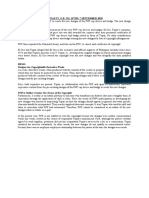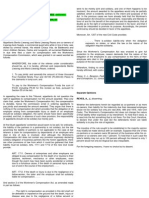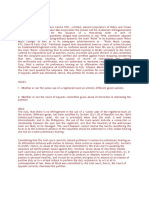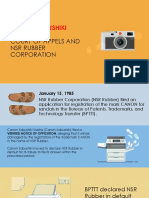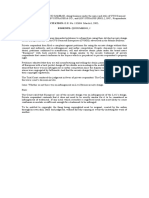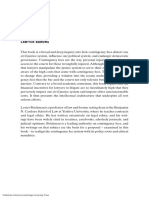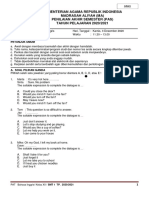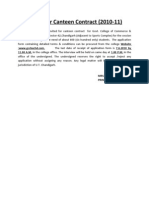Esso Standard, Inc. vs. Ca
Esso Standard, Inc. vs. Ca
Uploaded by
Alljun SerenadoCopyright:
Available Formats
Esso Standard, Inc. vs. Ca
Esso Standard, Inc. vs. Ca
Uploaded by
Alljun SerenadoOriginal Description:
Original Title
Copyright
Available Formats
Share this document
Did you find this document useful?
Is this content inappropriate?
Copyright:
Available Formats
Esso Standard, Inc. vs. Ca
Esso Standard, Inc. vs. Ca
Uploaded by
Alljun SerenadoCopyright:
Available Formats
ESSO STANDARD, INC. VS.
CA
FACTS:
Esso Standard Eastern, Inc. (ESC), then a foreign corporation duly licensed to do business in
the Philippines, is engaged in the sale of petroleum products which are identified with its trademark
ESSO (which as successor of the defunct Standard Vacuum Oil Co. it registered as a business name with
the Bureaus of Commerce and Internal Revenue.
United Cigarette Corporation (UCC), is a domestic corporation then engaged in the manufacture
and sale of cigarettes, after it acquired the business, factory and patent rights of its predecessor La
Oriental Tobacco Corporation, one of the rights thus acquired having been the use of the trademark
ESSO on its cigarettes, for which a permit had been duly granted by the Bureau of Internal Revenue.
ESC commenced a case for trademark infringement against UCC. The complaint alleged that
ESC had been for many years engaged in the sale of petroleum products and its trademark “ESSO” had
acquired a considerable goodwill to such an extent that the buying public had always taken the
trademark ESSO as equivalent to high quality petroleum products. ESC asserted that the continued use
by private respondent of the same trademark “ESSO” on its cigarettes was being carried out for the
purpose of deceiving the public as to its quality and origin to the detriment and disadvantage of its own
products.
In its answer, respondent admitted that it used the trademark ESSO on its own product of
cigarettes, which was not identical to those produced and sold by petitioner and therefore did not in any
way infringe on or imitate petitioner's trademark. Respondent contended that in order that there may
be trademark infringement, it is indispensable that the mark must be used by one person in connection
or competition with goods of the same kind as the complainant's.
TC decided in favor of ESC and ruled that respondent was guilty of infringement of trademark.
On appeal, respondent CA found that there was no trademark infringement and dismissed the complaint,
as well as ESC’s MR.
ISSUE: WON UCC is guilty of patent infringement. (NO CYST)
RULING:
The law defines infringement as the use without consent of the trademark owner of any
"reproduction, counterfeit, copy or colorable imitation of any registered mark or tradename in connection
with the sale, offering for sale, or advertising of any goods, business or services on or in connection
with which such use is likely to cause confusion or mistake or to deceive purchasers or others as to the
source or origin of such goods or services, or identity of such business; or reproduce, counterfeit, copy
or colorably imitate any such mark or tradename and apply such reproduction, counterfeit, copy or
colorable imitation to labels, signs, prints, packages, wrappers, receptacles or advertisements intended
to be used upon or in connection with such goods, business or services."
Implicit in this definition is the concept that the goods must be so related that there is a
likelihood either of confusion of goods or business. But likelihood of confusion is a relative concept; to
be determined only according to the particular, and sometimes peculiar, circumstances of each case.
It is undisputed that the goods on which petitioner uses the trademark ESSO, petroleum
products, and the product of respondent, cigarettes, are non-competing. But as to whether trademark
infringement exists depends for the most part upon whether or not the goods are so related that the
public may be, or is actually, deceived and misled that they came from the same maker or manufacturer.
NON-COMPETING GOODS VS. RELATED GOODS
Non-competing goods may be those which, though they are not in actual competition, are so
related to each other that it might reasonably be assumed that they originate from one manufacturer.
Non-competing goods may also be those which, being entirely unrelated, could not reasonably be
assumed to have a common source. In the former case of related goods, confusion of business could
arise out of the use of similar marks; in the latter case of non-related goods, it could not. The vast
majority of courts today follow the modern theory or concept of "related goods" which the Court has
likewise adopted and uniformly recognized and applied.
Goods are related when they belong to the same class or have the same descriptive
properties; when they possess the same physical attributes or essential characteristics with
reference to their form, composition, texture or quality. They may also be related because
they serve the same purpose or are sold in grocery stores.
In the situation before us, the goods are obviously different from each other — with "absolutely
no iota of similitude" as stressed in respondent court's judgment. They are so foreign to each other as
to make it unlikely that purchasers would think that petitioner is the manufacturer of respondent's
goods. The mere fact that one person has adopted and used a trademark on his goods does not prevent
the adoption and use of the same trademark by others on unrelated articles of a different kind.
Although petitioner's products are numerous, they are of the same class or line of merchandise
which are noncompeting with respondent's product of cigarettes, which as pointed out in the appealed
judgment is beyond petitioner's "zone of potential or natural and logical expansion." When a trademark
is used by a party for a product in which the other party does not deal, the use of the same trademark
on the latter's product cannot be validly objected to.
DIFFERENT CHANNELS OF TRADE
Another factor that shows that the goods involved are non-competitive and nonrelated is the
appellate court's finding that they flow through different channels of trade. ESC products are distributed
principally through gasoline service and lubrication stations, automotive shops and hardware stores. On
the other hand, the UCC’s cigarettes are sold in sari-sari stores, grocery stores, and other small
distributor outlets, they are even peddled in the streets while (petitioner's) 'gasul' burners are not.
DIFFERENT APPEARANCES OF TRADEMARK
Respondent court correctly ruled that considering the general appearances of each mark as a
whole, the possibility of any confusion is unlikely. Generally, the plaintiff's trademark comes all in either
red, white, blue or any combination of the three colors. It is to be pointed out that not even a shade of
these colors appears on the trademark of the appellant's cigarette. The only color that the appellant
uses in its trademark is green."
You might also like
- Republic vs. Tupaz (G.r. No. 197335)Document1 pageRepublic vs. Tupaz (G.r. No. 197335)Alljun Serenado100% (2)
- Pakistan Tobacco Company: Operations & Production ManagementDocument26 pagesPakistan Tobacco Company: Operations & Production ManagementPeter Lee100% (5)
- The WaxmanDocument122 pagesThe WaxmanMohamed Med100% (1)
- Fruit of The Loom Inc V CADocument2 pagesFruit of The Loom Inc V CAJaz SumalinogNo ratings yet
- DEPARTMENT OF EDUCATION vs. RIZAL TEACHERS KILUSANG BAYAN FOR CREDIT, INC.Document1 pageDEPARTMENT OF EDUCATION vs. RIZAL TEACHERS KILUSANG BAYAN FOR CREDIT, INC.Alljun SerenadoNo ratings yet
- MANILA INTERNATIONAL AIRPORT AUTHORITY vs. COMMISSION ON AUDITDocument1 pageMANILA INTERNATIONAL AIRPORT AUTHORITY vs. COMMISSION ON AUDITAlljun SerenadoNo ratings yet
- Internship Report On Implementation of The Integrated Work System in The Secondary Manufacturing Department of British American Tobacco BangladeshDocument49 pagesInternship Report On Implementation of The Integrated Work System in The Secondary Manufacturing Department of British American Tobacco BangladeshMark Anthony Caro0% (1)
- IQOS Paper 2-21-2020FDocument313 pagesIQOS Paper 2-21-2020Falexandra popescu100% (1)
- Sasot vs. People GR No. 143193 (June 29,2005)Document11 pagesSasot vs. People GR No. 143193 (June 29,2005)Airah MacabandingNo ratings yet
- The East Pacific Merchandising Corporation vs. The Director of Patents and Luis P. PellicerDocument31 pagesThe East Pacific Merchandising Corporation vs. The Director of Patents and Luis P. PellicerRalph HonoricoNo ratings yet
- IP - Patent and TrademarkDocument2 pagesIP - Patent and TrademarkAnne Janelle GuanNo ratings yet
- Brocka vs. Enrile, 192 SCRA 183, 188Document1 pageBrocka vs. Enrile, 192 SCRA 183, 188Catherine ToralloNo ratings yet
- Identical Mark - Ang V TeodoroDocument1 pageIdentical Mark - Ang V TeodoroMarioneMaeThiamNo ratings yet
- Parke Davis and Company VsDocument1 pageParke Davis and Company VsLadyfirst MANo ratings yet
- Ynot Vs Intermediate Appellate CourtDocument1 pageYnot Vs Intermediate Appellate CourtMaria Angelica DavidNo ratings yet
- Birkenstock Orthopaedie GMBH and Co. KG Vs Philippine Shoe Expo Marketing Corporation, G.R. No. 194307. November 20, 2013Document3 pagesBirkenstock Orthopaedie GMBH and Co. KG Vs Philippine Shoe Expo Marketing Corporation, G.R. No. 194307. November 20, 2013Denise DianeNo ratings yet
- Phil Refining Company V NG SamDocument1 pagePhil Refining Company V NG SamAliw del RosarioNo ratings yet
- Mighty Corporation v. E & J Gallo Winery, G.R. No. 154342, July 14, 2014Document18 pagesMighty Corporation v. E & J Gallo Winery, G.R. No. 154342, July 14, 2014Tia RicafortNo ratings yet
- Case Digest On PatentsDocument24 pagesCase Digest On PatentsEnriqueAngeloDolotallas100% (1)
- Liwanag Vs WorkmensDocument1 pageLiwanag Vs WorkmensCrizza CozNo ratings yet
- Venancio Sambar V Levi Stauss Elements of CopyrightabilityDocument1 pageVenancio Sambar V Levi Stauss Elements of CopyrightabilityArah Salas PalacNo ratings yet
- Abercrombie & Fitch vs. Hunting WorldDocument5 pagesAbercrombie & Fitch vs. Hunting WorldRona TumaganNo ratings yet
- Graham v. John Deere Co., 383 U.S. 1Document15 pagesGraham v. John Deere Co., 383 U.S. 1Tia RicafortNo ratings yet
- Republic Vs Judge HidalgoDocument16 pagesRepublic Vs Judge HidalgoMikkoletNo ratings yet
- Shang Properties Realty v. St. Francis Development Corp.Document4 pagesShang Properties Realty v. St. Francis Development Corp.Darlene GanubNo ratings yet
- 246 Corporation V DawayDocument8 pages246 Corporation V DawayMp CasNo ratings yet
- Al Ghoul VS CaDocument4 pagesAl Ghoul VS CaJoshuaLavegaAbrinaNo ratings yet
- Dermaline Vs Myra PharmaDocument2 pagesDermaline Vs Myra PharmaKylie Kaur Manalon DadoNo ratings yet
- Estrada Vs DesiertoDocument2 pagesEstrada Vs DesiertoMajorie ArimadoNo ratings yet
- PHILIPPINE NUT INDUSTRY V Standard Brands INC PDFDocument2 pagesPHILIPPINE NUT INDUSTRY V Standard Brands INC PDFjj martinezNo ratings yet
- ALIGATO Canon Kabushiki V NSR TrademarkDocument15 pagesALIGATO Canon Kabushiki V NSR TrademarkShivaNo ratings yet
- 1254 RamDocument3 pages1254 RamNiala AlmarioNo ratings yet
- Shangri-La International Hotel Management Ltd. vs. Court of AppealsDocument3 pagesShangri-La International Hotel Management Ltd. vs. Court of AppealsGeenea VidalNo ratings yet
- Berris Agricultural Co V AbyadangDocument4 pagesBerris Agricultural Co V AbyadangJenny DagunNo ratings yet
- Phil Refining Co. vs. NG SamDocument1 pagePhil Refining Co. vs. NG Samsimon gibalayNo ratings yet
- Patents #3 - Creser V CA GR No 118708Document2 pagesPatents #3 - Creser V CA GR No 118708Dan ChuaNo ratings yet
- MKHDocument2 pagesMKHPauline DgmNo ratings yet
- YNTIG - Sambar Vs Levi Strauss CaseDocument1 pageYNTIG - Sambar Vs Levi Strauss CaseDave UrotNo ratings yet
- Ching Vs Salinas, GR No. 161295Document3 pagesChing Vs Salinas, GR No. 161295WrenNo ratings yet
- SONY V SupergreenDocument2 pagesSONY V SupergreenErikEspinoNo ratings yet
- Facts:: 11. Gsell vs. Yap-Jue (G.R. No. 4720)Document3 pagesFacts:: 11. Gsell vs. Yap-Jue (G.R. No. 4720)Kenn PacatangNo ratings yet
- Chua Che V Philippine Patent OfficeDocument3 pagesChua Che V Philippine Patent OfficenayowmeeNo ratings yet
- Intellectual Property Rights in The Philippines Brief BackgroundDocument30 pagesIntellectual Property Rights in The Philippines Brief BackgroundSushenSisonNo ratings yet
- LEGAL MEDICINE - NOTES 2019N (From Atty Riego) PDFDocument17 pagesLEGAL MEDICINE - NOTES 2019N (From Atty Riego) PDFEmman FernandezNo ratings yet
- MAGUAN V COURT OF APPEALSDocument2 pagesMAGUAN V COURT OF APPEALSCedricNo ratings yet
- 21.people v. Rodriguez, 135 Phil. 485Document11 pages21.people v. Rodriguez, 135 Phil. 485NEWBIENo ratings yet
- Birkenstock v. Phil. Shoe Expo - DIGESTDocument2 pagesBirkenstock v. Phil. Shoe Expo - DIGESTGabrielle DayaoNo ratings yet
- ASIA PACIFIC RESOURCES INTERNATIONAL HOLDINGS, LTD., Vs.. PAPERONE, INC.Document12 pagesASIA PACIFIC RESOURCES INTERNATIONAL HOLDINGS, LTD., Vs.. PAPERONE, INC.louryNo ratings yet
- Rosario Textile Mills Corporation VDocument122 pagesRosario Textile Mills Corporation VNafie ImlaniNo ratings yet
- Pearl N Dean V Shoemart DigestDocument2 pagesPearl N Dean V Shoemart DigestCeledonio ManubagNo ratings yet
- Converse Vs Jacinto - OdtDocument15 pagesConverse Vs Jacinto - OdtJMNo ratings yet
- Graham Vs John Deere DigestDocument2 pagesGraham Vs John Deere Digestcarl dianne100% (1)
- SERI SOMBOONSAKDIKUL Vs ORLANEDocument2 pagesSERI SOMBOONSAKDIKUL Vs ORLANEsweet dudeNo ratings yet
- People vs. RamosDocument3 pagesPeople vs. RamosMarlon BasallajeNo ratings yet
- In Re Morales 571 SCRA 361 NOVEMBER 19, 2008 Nature of ActionDocument6 pagesIn Re Morales 571 SCRA 361 NOVEMBER 19, 2008 Nature of ActionLina DiazNo ratings yet
- East Pacific Merchandising Vs Dir of PatentsDocument1 pageEast Pacific Merchandising Vs Dir of PatentsCharlotte100% (1)
- 07 Northern Motors V SapinosoDocument2 pages07 Northern Motors V SapinosoAgus DiazNo ratings yet
- Case # Embrado Vs CADocument4 pagesCase # Embrado Vs CAFses MandaluyongNo ratings yet
- De Castro v. Court of Appeals: G.R. No. 115838, 18 July 2002 FactsDocument3 pagesDe Castro v. Court of Appeals: G.R. No. 115838, 18 July 2002 FactsBenjie SalesNo ratings yet
- Alhambra Cigar Vs - Pedro N. Mojica Digest FactsDocument5 pagesAlhambra Cigar Vs - Pedro N. Mojica Digest FactsVictoriaAlmeriaGonzalesNo ratings yet
- Te Vs BrevaDocument8 pagesTe Vs BrevaRodney AtibulaNo ratings yet
- Chua Che v. Philippines Patent OfficeDocument1 pageChua Che v. Philippines Patent OfficeJoe CuraNo ratings yet
- IPL HW 1Document52 pagesIPL HW 1Hyuga NejiNo ratings yet
- Societe Des Produits Nestle v. Dy, G.R. No. 1722276, 8 August 2010Document8 pagesSociete Des Produits Nestle v. Dy, G.R. No. 1722276, 8 August 2010Dyords TiglaoNo ratings yet
- Creser v. CADocument2 pagesCreser v. CASean GalvezNo ratings yet
- 02 Esso Standard Eastern, Inc. V CADocument2 pages02 Esso Standard Eastern, Inc. V CAeieipayadNo ratings yet
- Esso Standard Eastern, Inc. Vs CA and United Cigarette CorporationDocument4 pagesEsso Standard Eastern, Inc. Vs CA and United Cigarette CorporationSarah De Guzman0% (1)
- Retuya vs. GorduizDocument1 pageRetuya vs. GorduizAlljun SerenadoNo ratings yet
- LOS BAÑOS VS. PEDRO (G.R. No. 173588, April 22, 2009)Document1 pageLOS BAÑOS VS. PEDRO (G.R. No. 173588, April 22, 2009)Alljun SerenadoNo ratings yet
- People vs. CanturiaDocument1 pagePeople vs. CanturiaAlljun Serenado100% (2)
- Rimando vs. Sps. Aldaba (GR No. 203583Document1 pageRimando vs. Sps. Aldaba (GR No. 203583Alljun Serenado0% (1)
- Dow Chemical France vs. Isover Saint Gobain FranceDocument1 pageDow Chemical France vs. Isover Saint Gobain FranceAlljun SerenadoNo ratings yet
- Office of The Court Administrator vs. Hon. Lagura-YapDocument1 pageOffice of The Court Administrator vs. Hon. Lagura-YapAlljun SerenadoNo ratings yet
- 08-17-2021 Part 1 (Modes of Acquiring Possession)Document2 pages08-17-2021 Part 1 (Modes of Acquiring Possession)Alljun SerenadoNo ratings yet
- 08-10-2021 (Natural-Born Citizens - Kinds of Direct Naturalization)Document2 pages08-10-2021 (Natural-Born Citizens - Kinds of Direct Naturalization)Alljun SerenadoNo ratings yet
- Gamboa vs. Finance Secretary TevesDocument1 pageGamboa vs. Finance Secretary TevesAlljun Serenado100% (1)
- Co V. Electoral Tribunal, 199 Scra 692 FactsDocument1 pageCo V. Electoral Tribunal, 199 Scra 692 FactsAlljun SerenadoNo ratings yet
- MONTEVILLA vs. VALLENADocument1 pageMONTEVILLA vs. VALLENAAlljun SerenadoNo ratings yet
- LANDBANK OF THE PHILIPPINES vs. MEGAWORDL CORPORATIONDocument1 pageLANDBANK OF THE PHILIPPINES vs. MEGAWORDL CORPORATIONAlljun SerenadoNo ratings yet
- PASAY CITY ALLIANCE CHURCH vs. BENITODocument1 pagePASAY CITY ALLIANCE CHURCH vs. BENITOAlljun SerenadoNo ratings yet
- GURRO vs. PEOPLE OF THE PHILIPPINESDocument1 pageGURRO vs. PEOPLE OF THE PHILIPPINESAlljun SerenadoNo ratings yet
- Ortega vs. ValmonteDocument1 pageOrtega vs. ValmonteAlljun SerenadoNo ratings yet
- CORDILLERA GLOBAL NETWORK vs. PAJEDocument1 pageCORDILLERA GLOBAL NETWORK vs. PAJEAlljun SerenadoNo ratings yet
- Cir vs. AsalusDocument1 pageCir vs. AsalusAlljun SerenadoNo ratings yet
- Estate Tax SuccessionDocument1 pageEstate Tax SuccessionAlljun SerenadoNo ratings yet
- Coca-Cola Bottlers Philippines Inc. vs. City of ManilaDocument1 pageCoca-Cola Bottlers Philippines Inc. vs. City of ManilaAlljun SerenadoNo ratings yet
- Silicon Philippines vs. CirDocument1 pageSilicon Philippines vs. CirAlljun SerenadoNo ratings yet
- Alvarez vs. IacDocument1 pageAlvarez vs. IacAlljun SerenadoNo ratings yet
- Rabadilla vs. CaDocument1 pageRabadilla vs. CaAlljun SerenadoNo ratings yet
- Petitioner Vs Vs Respondents Gibbs, Mcdonough & Johnson Attorney-General Villa-Real Araneta & Zaragoza (Amici Curiae)Document7 pagesPetitioner Vs Vs Respondents Gibbs, Mcdonough & Johnson Attorney-General Villa-Real Araneta & Zaragoza (Amici Curiae)Alljun SerenadoNo ratings yet
- Plaintiff-Appellant Vs Vs Defendants. Appellee Ross, Lawrence & Selph Attorney-General Villa-RealDocument9 pagesPlaintiff-Appellant Vs Vs Defendants. Appellee Ross, Lawrence & Selph Attorney-General Villa-RealAlljun SerenadoNo ratings yet
- Rajani by DivyabenDocument62 pagesRajani by DivyabenSahil PatelNo ratings yet
- Lawyer Barons by Lester BrickmanDocument524 pagesLawyer Barons by Lester BrickmanADNo ratings yet
- ITC HistoryDocument34 pagesITC HistorySrivastav GauravNo ratings yet
- The Online Shopper's Guide To Buy Weed Online in CanadaDocument3 pagesThe Online Shopper's Guide To Buy Weed Online in Canadatailangora48No ratings yet
- Mighty Corporation Vs e & J Gallo Winery DigestDocument6 pagesMighty Corporation Vs e & J Gallo Winery DigestRegine Joy MagaboNo ratings yet
- Using Complex Sentences To Show Problem-Solution Relationship ofDocument11 pagesUsing Complex Sentences To Show Problem-Solution Relationship ofMaricel Palmes Encabo PalomilloNo ratings yet
- SOAL B.Inggris - XII - WajibDocument11 pagesSOAL B.Inggris - XII - WajiblaroibafiNo ratings yet
- Audio ScriptsDocument6 pagesAudio ScriptsNguyên NguyễnNo ratings yet
- Bloomberg Businessweek - 15 February 2016Document68 pagesBloomberg Businessweek - 15 February 2016kaduskyNo ratings yet
- Rapaport-Pipemaking 101Document7 pagesRapaport-Pipemaking 101JimNo ratings yet
- Employee Accommodation Policy v1.0Document15 pagesEmployee Accommodation Policy v1.0Diksha ShettyNo ratings yet
- Research Paper - FinalDocument15 pagesResearch Paper - FinalCyril ScariaNo ratings yet
- Solutions To Exercises - Print PDFDocument72 pagesSolutions To Exercises - Print PDFDANILO LATIFONo ratings yet
- Canteen Contract 2010-11Document10 pagesCanteen Contract 2010-11mohamadpmbNo ratings yet
- Gold FlakeDocument31 pagesGold FlakeShivendra SinghNo ratings yet
- Lesson NotesDocument133 pagesLesson NotesJoselle RuizNo ratings yet
- Phuket Cheat Sheet - 01Document32 pagesPhuket Cheat Sheet - 01silvof100% (1)
- ITC Limited: One of India's Most Admired and Valuable CompaniesDocument65 pagesITC Limited: One of India's Most Admired and Valuable Companieshelloamit1991No ratings yet
- Presentation For Contract and Procurement Management ITM 5300 - FinalDocument26 pagesPresentation For Contract and Procurement Management ITM 5300 - FinalujwalkandimallaNo ratings yet
- Itc History and EvolutionDocument7 pagesItc History and EvolutionDevika JoharNo ratings yet
- Personal Values, Advertising, and Smoking Motivation in Taiwanese AdolescentsDocument16 pagesPersonal Values, Advertising, and Smoking Motivation in Taiwanese AdolescentsconstantinNo ratings yet
- Schedule Trip of Oxva in IndonesiaDocument4 pagesSchedule Trip of Oxva in IndonesiaVincent AndriasNo ratings yet
- IjniDocument21 pagesIjninitinmemNo ratings yet
- Sentence TransformationDocument5 pagesSentence TransformationJohn WilkinsNo ratings yet
- Adklasjd KlasdjlkDocument4 pagesAdklasjd Klasdjlksab754No ratings yet
- Changes in The Integration of Art and Copy From 1960 To PresentDocument53 pagesChanges in The Integration of Art and Copy From 1960 To PresentAddison BornNo ratings yet
